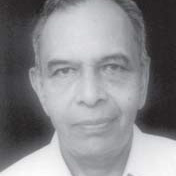Mahinder Singh Pujji was born in Simla on 14 August 1918. His father was a senior officer in the Health and Education Department. Mahinder was educated at Sir Harcourt Butler High School, Simla and later at Government College, Lahore and Hindu College, Lahore.
He had an interest in flying and learnt it as a hobby. He received “A” License in April 1937 and took up a job with Himalayan Airways flying passengers between Hardwar and Badrinath. After working for Burma Shell for a short while, he got a Volunteer Reserve Commission in the Indian Air Force. He was one of the first of the batch of 24 “A’ license holders to join the Reserve Commission. He was one of the 18 qualified Indian pilots who joined the Royal Air Force (RAF) in 1940. He flew from the main RAF stations in UK to defend London and took part in the Allies first offensive operations in France. He also flew in Burma, China and India. In Burma, he had served with the well-known Air Commander “Baba” Mehar Singh.
Mahinder Singh carried out daring exploits as fighter pilot and was forced to land in North African desert in 1941. He was picked up by British troops. In a dog fight with a Messerschmitt plane over France, his dashboard was shattered by a bullet which pierced through his uniform. All the instruments were destroyed and oil was pouring out of the engine. He could see the white cliffs and as he put the landing gear down, the plane was on fire. Blood was pouring from his head. He was saved by the turban which acted like a helmet. The aircraft was a wreck and he was dragged out of the plane. He could hear voices that “he is still alive.”
On another occasion, his turban was filled with blood when forced to land in France. He carried a spare turban. Due to insistence on wearing a turban, he could not wear an oxygen mask which cost him irreparable damage to lungs at high altitude. He was awarded Distinguished Flying Cross (DFC) for gallant actions in Burma. He loved flying and after a career as a commercial pilot in India, he retired to Gravesend in UK. He also published a book of his experiences “For King and Another Country.”
Pujji was treated as a hero during war time. He would be pushed to the front of the queue in cinema houses and he would not be charged in restaurants. He fell in love with UK. It changed after the war. The role of the Indian airmen was forgotten. After the war, films like the Dam Busters presented only a white view. He was pained at being ignored and not invited to the Remembrance Day ceremony. Recently, there has been an attempt to recognise the contribution of ethnic minorities in World War II. Journalists, politicians and historians have begun to narrate the stories of the achievements of people from the colonies.
A few years before his death an exhibition was organised at RAF Museum Crossword in Shorpshire that recognised the role of personnel from the colonies. Seventeen thousand Indians had offered to join the RAF and 25000 had joined the Indian Air Force. Pujji was the guest of honour at the exhibition.
In later years, he dedicated his life to helping people in need and he received a life time achievement award from Gravesham council.
In 2011, a short film ‘The Volunteers’ was dedicated to Pujji. He had contributed to making it but died before it was completed. A statue was built in his honour and was unveiled at St Andrews Gardens in November 2014.
Pujji died of a stroke at Darent Valley Hospital on 18 September 2010.


 [/column]
[/column]